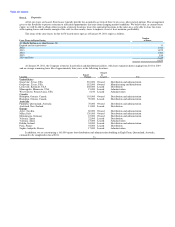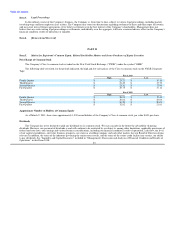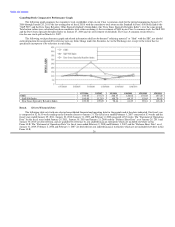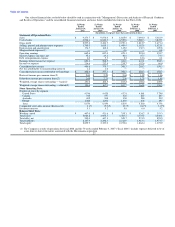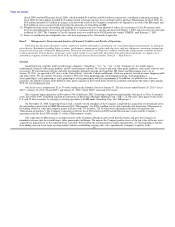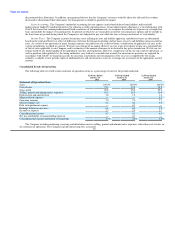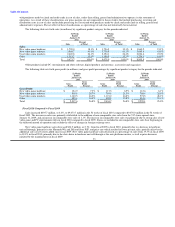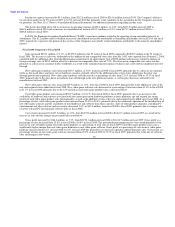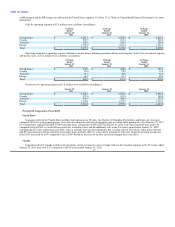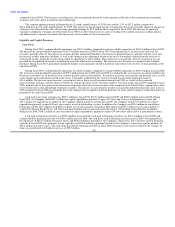GameStop 2010 Annual Report Download - page 46
Download and view the complete annual report
Please find page 46 of the 2010 GameStop annual report below. You can navigate through the pages in the report by either clicking on the pages listed below, or by using the keyword search tool below to find specific information within the annual report.
Table of Contents
vendors, its current cost is added to the existing cost of product on-hand and this amount is re-averaged over the cumulative units. Used video
game products traded in by customers are recorded as inventory at the amount of the store credit given to the customer. In valuing inventory,
management is required to make assumptions regarding the necessity of reserves required to value potentially obsolete or over-valued items at
the lower of cost or market. Management considers quantities on hand, recent sales, potential price protections and returns to vendors, among
other factors, when making these assumptions. Our ability to gauge these factors is dependent upon our ability to forecast customer demand
and to provide a well-balanced merchandise assortment. Any inability to forecast customer demand properly could lead to increased costs
associated with inventory markdowns. We also adjust inventory based on anticipated physical inventory losses or shrinkage. Physical
inventory counts are taken on a regular basis to ensure the reported inventory is accurate. During interim periods, estimates of shrinkage are
recorded based on historical losses in the context of current period circumstances.
Property and Equipment. Property and equipment are carried at cost less accumulated depreciation and amortization. Depreciation on
furniture, fixtures and equipment is computed using the straight-line method over estimated useful lives (ranging from two to eight years).
Maintenance and repairs are expensed as incurred, while betterments and major remodeling costs are capitalized. Leasehold improvements are
capitalized and amortized over the shorter of their estimated useful lives or the terms of the respective leases, including renewal options in
which the exercise of the option is reasonably assured (generally ranging from three to ten years). Costs incurred to third parties in purchasing
management information systems are capitalized and included in property and equipment. These costs are amortized over their estimated
useful lives from the date the systems become operational. The Company periodically reviews its property and equipment whenever events or
changes in circumstances indicate that their carrying amounts may not be recoverable or their depreciation or amortization periods should be
accelerated. The Company assesses recoverability based on several factors, including management's intention with respect to its stores and
those stores' projected undiscounted cash flows. An impairment loss is recognized for the amount by which the carrying amount of the assets
exceeds their fair value, as approximated by the present value of their projected cash flows. Write-downs incurred by the Company through
January 29, 2011 have not been material.
Goodwill. Goodwill, aggregating $1,996.3 million, has been recorded as of January 29, 2011 related to various acquisitions. Goodwill
represents the excess purchase price over tangible net assets and identifiable intangible assets acquired. The Company is required to evaluate
goodwill and other intangible assets not subject to amortization for impairment at least annually. This test is completed at the beginning of the
fourth quarter each fiscal year or when circumstances indicate the carrying value of the goodwill or other intangible assets might be impaired.
Goodwill has been assigned to reporting units for the purpose of impairment testing. The Company has four business segments, the United
States, Australia, Canada and Europe, which also define our reporting units based upon the similar economic characteristics of operations
within each segment, including the nature of products, product distribution and the type of customer and separate management within those
regions. The Company estimates fair value based on the discounted cash flows of each reporting unit. The Company uses a two-step process to
measure goodwill impairment. If the fair value of the reporting unit is higher than its carrying value, then goodwill is not impaired. If the
carrying value of the reporting unit is higher than the fair value, then the second test of goodwill impairment is needed. The second test
compares the implied fair value of the reporting unit's goodwill with its carrying amount. If the carrying amount of the reporting unit's
goodwill exceeds the implied fair value, then an impairment loss is recognized in the amount of the excess. If the carrying value of an
individual indefinite-life intangible asset exceeds its fair value, such individual indefinite-life intangible asset is written down by the amount of
the excess. The Company completed its annual impairment test of goodwill on the first day of the fourth quarter of fiscal 2008, fiscal 2009 and
fiscal 2010 and concluded that none of its goodwill was impaired. Note 8 of "Notes to Consolidated Financial Statements" provides additional
information concerning goodwill.
The discounted cash flow method used to determine the fair value of reporting units requires management to make significant judgments
based on the Company's projected sales and gross margin, annual business plans, future business strategies and economic factors. Discount
rates used in the analysis reflect the Company's weighted average cost of capital, current market rates and the risks associated with the
projected 30





